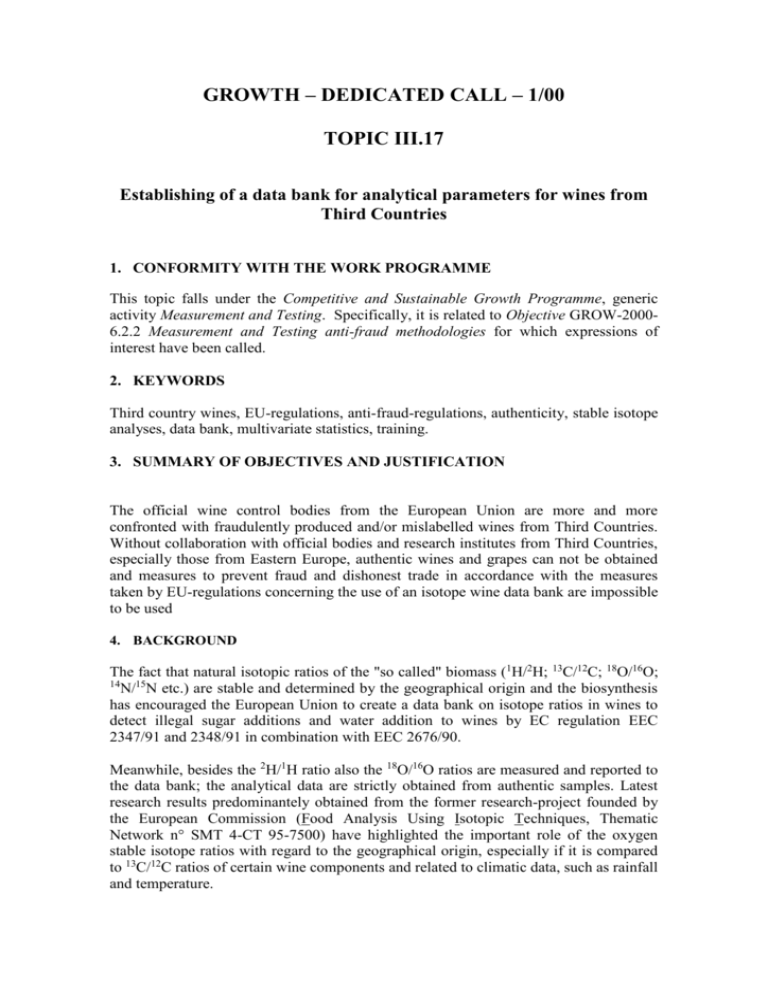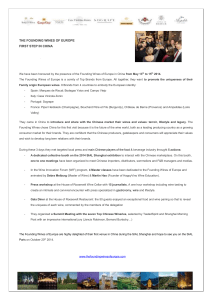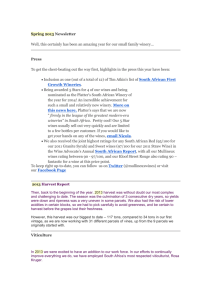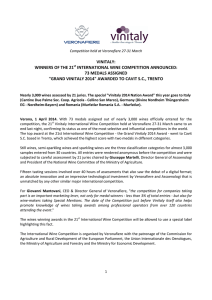MS Word - CORDIS
advertisement

GROWTH – DEDICATED CALL – 1/00 TOPIC III.17 Establishing of a data bank for analytical parameters for wines from Third Countries 1. CONFORMITY WITH THE WORK PROGRAMME This topic falls under the Competitive and Sustainable Growth Programme, generic activity Measurement and Testing. Specifically, it is related to Objective GROW-20006.2.2 Measurement and Testing anti-fraud methodologies for which expressions of interest have been called. 2. KEYWORDS Third country wines, EU-regulations, anti-fraud-regulations, authenticity, stable isotope analyses, data bank, multivariate statistics, training. 3. SUMMARY OF OBJECTIVES AND JUSTIFICATION The official wine control bodies from the European Union are more and more confronted with fraudulently produced and/or mislabelled wines from Third Countries. Without collaboration with official bodies and research institutes from Third Countries, especially those from Eastern Europe, authentic wines and grapes can not be obtained and measures to prevent fraud and dishonest trade in accordance with the measures taken by EU-regulations concerning the use of an isotope wine data bank are impossible to be used 4. BACKGROUND The fact that natural isotopic ratios of the "so called" biomass (1H/2H; 13C/12C; 18O/16O; 14 15 N/ N etc.) are stable and determined by the geographical origin and the biosynthesis has encouraged the European Union to create a data bank on isotope ratios in wines to detect illegal sugar additions and water addition to wines by EC regulation EEC 2347/91 and 2348/91 in combination with EEC 2676/90. Meanwhile, besides the 2H/1H ratio also the 18O/16O ratios are measured and reported to the data bank; the analytical data are strictly obtained from authentic samples. Latest research results predominantely obtained from the former research-project founded by the European Commission (Food Analysis Using Isotopic Techniques, Thematic Network n° SMT 4-CT 95-7500) have highlighted the important role of the oxygen stable isotope ratios with regard to the geographical origin, especially if it is compared to 13C/12C ratios of certain wine components and related to climatic data, such as rainfall and temperature. DC 1/00/Topic III.17/ Pg 2 Therefore, it is foreseen that also the carbon isotope ratios will be implemented to the European wine data bank as soon as the analytical method is internationally validated. The isotope data bank has proven to be a strong measure against fraudulent sugar additions to musts and wines and is more and more used to detect other frauds, such as water additions, redilution and fermentation of concentrated musts and mislabelling with regard to the geographical origin and grape variety. For wines being imported to the European Union the situation is completely different. Official wine control bodies are more and more confronted with suspicious wines from third countries, which can not be taken from the market, because authentic material is not available for comparability checks. All attempts to contact official control bodies in producing countries from Central and Eastern Europe to receive authentic grapes and wines, have failed so far. Therefore, activities in some EU countries have been initiated to create a data base for wines from retail markets which appear unsuspicious and common in trade. Basic statistics are used for the time being to enable interpretation. The tasks of this project aim at the creation of data bases from authentic samples from Third Countries and from samples common in trade. Both data bases will be evaluated by multivariate statistical methods to answer the following questions: 1. Is it possible by statistical models to simulate authentic data bases from trade samples? 2. Which analytical parameters other than stable isotope ratios are important to distinguish between different geographical origins? 3. In how far can climatic data contribute to an interpretation enhancement? 4. What kind of statistics must be used for an accepted and harmonized data interpretation in the case of unknown samples? The problems concerned with wine imports from third countries into the European Union have already been subject of discussions within the wine expert groups in the Directorate General for Agriculture, the EU 2H-NMR Data Bank Subcommittee of the JRC and the International Wine Office (Office International de la Vigne et du Vin, OIV). 5. ECONOMIC AND SOCIAL BENEFITS The countries of the European Union are the main wine producers in the world. To the same time the EU is the main wine importing part in the world. Alone Germany for instance has imported 1.828.376 hl from Third Countries in 1997 equivalent to a value of 337.237.000 DM. In 1998 this latter value was increased by 15.5 % (source: Europ. Comm. C 392/8 and Deutscher Weinbau Verband). Wines marketed in the EU must comply with EU legislation, especially EEC 822/87, laying down the enological practices allowed. With regard to fair competition in the EU market it is necessary to detect and reject fraudulent products. The proposed project will help to support effective European wine control measures and in parallel helps countries from Central and Eastern Europe and from overseas to move DC 1/00/Topic III.17/ Pg 3 forward in accepting and adopting EU-legislation. Moreover, the sampling procedures for authentic grapes and wines as well as the analytical instrumentation and knowledge, especially as it concerns isotopic measurements (NMR, IRMS), can be set up and enhanced thereby. The training of scientists through exchange is therefore part of the project. The statistics developed within this project on the other hand will have an impact on a better handling and interpretation of the existing EU-wine data bank, since the procedure presently applied requires the collection of authentic grapes under official control, which is extremely costly with regard to organisation, sampling and vinification procedures and personnel. 6. SCIENTIFIC AND TECHNOLOGICAL OBJECTIVES The principle research objectives are: The building up of sampling and documentation systems in accordance with EEC regulations in Third Countries The creation of a data base from wines common in trade from Third Countries The measurement of isotopic and other analytical parameters of these wines Multivariate statistical evaluation of all data and correlation between data from authentic wines and those common in trade Application of obtained knowledge to actual problems. Training of scientists from Third countries to transfer analytical knowledge and adopt and EU wine control measures. Help in setting up accredited laboratory units in Central and East European countries A close cooperation with the concerned Commission services (DG AGRI, RELEX, OLAF, JRC), official competent laboratories for wine analysis, especially those being capable of stable isotope analysis, university and wine industry and OIV is recommended. Technology transfer is an important part of this project to implement EU control measures in Third Countries. Since the data bank as an outcome of the project and its scientific results will be an important basis for EU-wine-control measures, the access will be restricted to official control bodies. Since the procedures and objectives for building up the data base should be in accordance with EEC Reg. No. 1932/97 (2348/91) partners in Third Countries should be official national authorities and laboratories, for instance as listed in Art. 4 (3) of EEC Reg. No. 3590/85 and published in the Official Journal of the European Communities 1999/C/46/06. Partners from wine industry are foreseen to contribute to the influence of oenology on natural wine constituents and isotopic ratios. It is the aim and the outcome of this project to maintain the sampling and measuring procedures to extend the existing European data base for the future. Therefore, the responsibility for the maintenance and updating of the databank after the end of the project should be clearly addressed in the proposal. DC 1/00/Topic III.17/ Pg 4 7. TIME SCALE Although no rigid timescale requirements apply to this project, a period of 3 years is considered as being realistic to conduct such a project.





